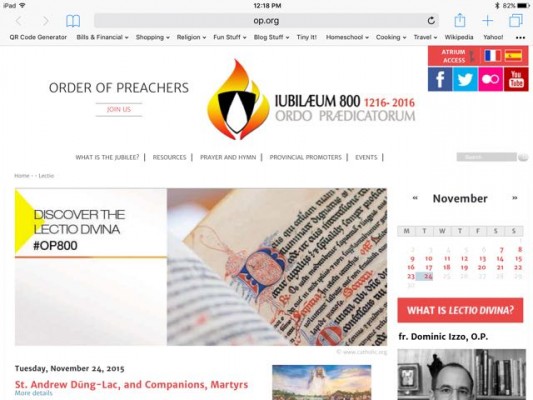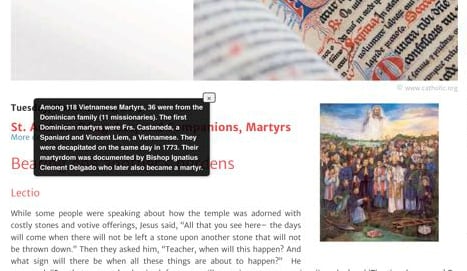In December 1216, Saint Dominic's new Order of Preachers was given official papal approval. This means that next year the Order that I am a part of as a Lay Dominican will celebrate 800 years of preaching the gospel! When you're 800 years old, and you look even better than Yoda, you tend to stretch that birthday celebration as long as you possibly can. On November 7, the Order of Preachers kicked off a year-long celebration of our anniversary which will continue through December 2016 – the official 800th anniversary of the Order. The Dominicans are celebrating this 800-year Jubilee in a variety of ways, one of which is a daily Lectio Divina resource online, with different Dominican friar writing each day about the day's readings for Mass.
What is Lectio Divina? That's a great question! (No, really. Don't feel bad if you don't know, because I needed to look it up to get a good grasp of it.) The USCCB quotes the Catechism of the Catholic Church with this explanation of the practice:
“The reading from the Word of God at each Hour . . . and readings from the Fathers and spiritual masters at certain Hours, reveal more deeply the meaning of the mystery being celebrated, assist in understanding the psalms, and prepare for silent prayer. The lectio divina, where the Word of God is so read and meditated that it becomes prayer, is thus rooted in the liturgical celebration.”
“Meditation engages thought, imagination, emotion, and desire. This mobilization of faculties is necessary in order to deepen our convictions of faith, prompt the conversion of our heart, and strengthen our will to follow Christ. Christian prayer tries above all to meditate on the mysteries of Christ, as in lectio divina or the rosary. This form of prayerful reflection is of great value, but Christian prayer should go further: to the knowledge of the love of the Lord Jesus, to union with him.” (1777, 2708)
In other words, following a format of Lectio Divina allows you to contemplate the Scriptures, pray about what God is revealing to you, and apply your contemplation to your daily life. The USCCB site linked above explains that there are four steps in Lectio Divina:
The method of lectio divina follows four steps: lectio (reading), meditatio (meditation), contemplatio (contemplation), and oratio (prayer).
Each of these four steps is contained in a single webpage that the Dominicans have set up for this Jubilee year.
The page has a sample of the Mass readings, as well as a link leading you to the USCCB page for the daily Mass readings, and then meditation, contemplation, and prayer for the day. You can use the calendar on the page to go back and find any days you might have missed, as well. If it happens to be a saint's feast day, there is also a pop-up that tells you a bit about that saint when you click on his name.
If you're looking for a way to get deeper into Scripture this Advent, I recommend giving Lectio Divina a try. Just bookmark this page on the Order of Preachers' site. The Lectio site is available in English, French, and Spanish. (Click on the little flag at the top-right of the page to switch.) And for more news about what the Dominicans are doing to celebrate our 800th anniversary, look for #OP800 on social media!
[gss columns="2" size="main-slider" ids="96674,96675"]
Read more of our Tech Talk columns.
©2015 Christine Johnson
Images @2015 Christine Johnson
About the Author

Christine Johnson
Christine Johnson has been married to Nathan since 1993 and is the mother of two homeschool graduates. She and Nathan live in the Blue Ridge Mountains of Southwest Virginia, where she tries to fit in as a transplanted Yank. She blogs at Domestic Vocation about her life as a wife, mother, and Lay Dominican.





.png?width=1806&height=731&name=CatholicMom_hcfm_logo1_pos_871c_2728c%20(002).png)
Comments